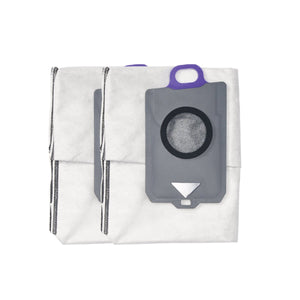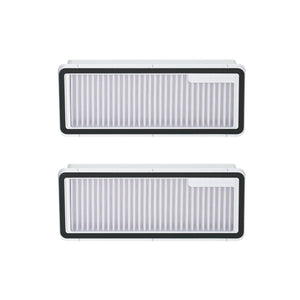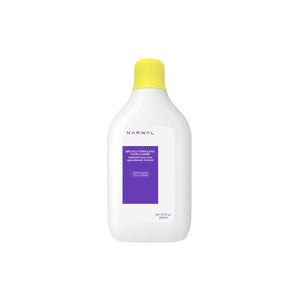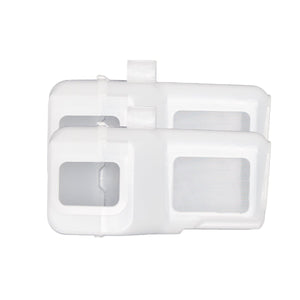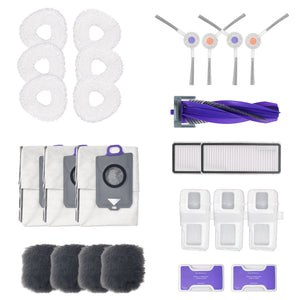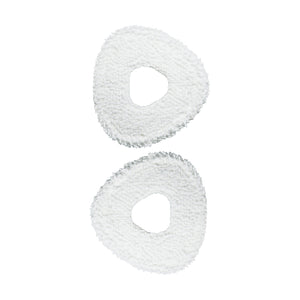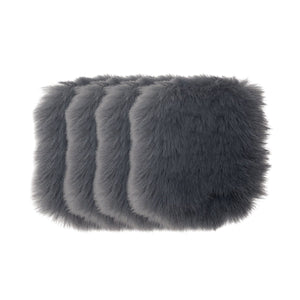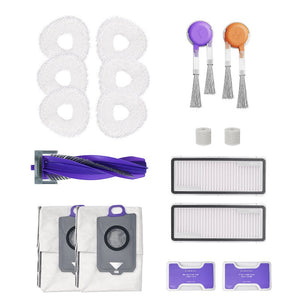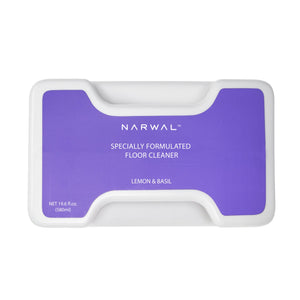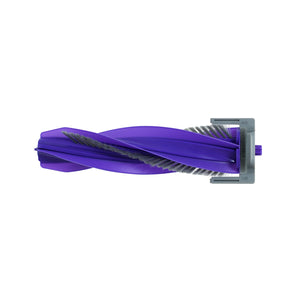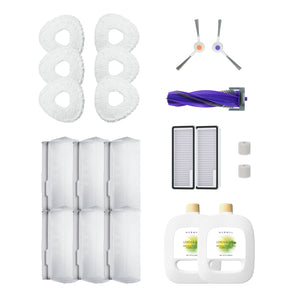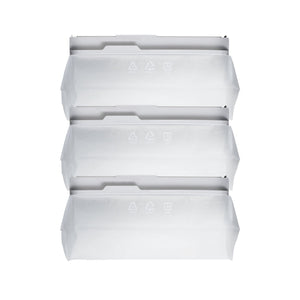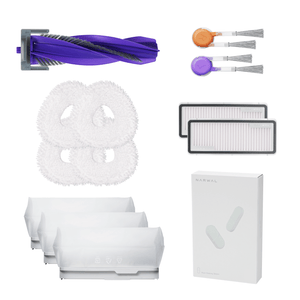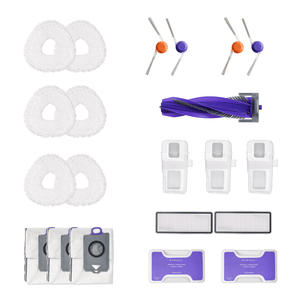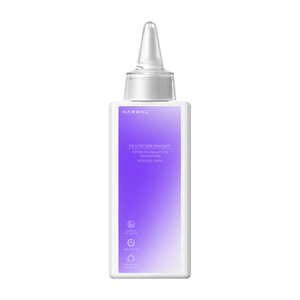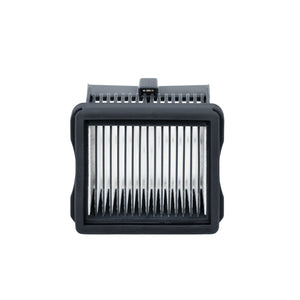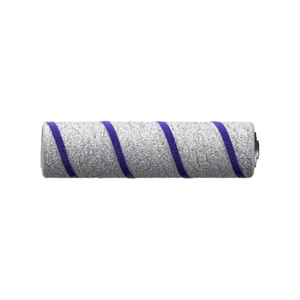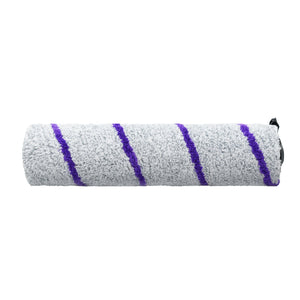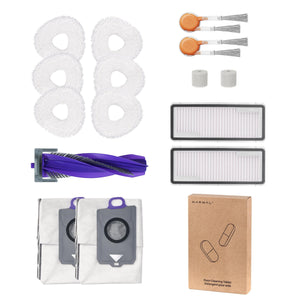Dust, tangled brushes, weak suction—sound familiar? Many robot vacuum owners find performance drops fast without proper care. Studies show regular maintenance can extend a robot vacuum’s lifespan by 2–3 years while cutting repair costs.
In this guide, you’ll learn the essential robot vacuum maintenance requirements: how to clean brushes, dustbins, and filters, keep sensors accurate, care for the battery, and even perform a full deep clean. We’ll also cover model-specific tips such as how to clean Narwal Freo Z Ultra, plus practical robot vacuum maintenance tips every user can apply. By the end, you’ll know exactly how to keep your device efficient, reliable, and long-lasting.
Benefits of Maintaining Your Robot Vacuum
-
Prolonged lifespan: Keeping your robot vacuum well-maintained ensures it lasts for years.
-
Consistent cleaning performance: A well-maintained vacuum performs at its best, ensuring your floors are always clean.
-
Reduced need for repairs: Regular upkeep can prevent many common issues, saving you from costly repairs.
Robot Vacuum Maintenance Overview
Here’s a quick overview of how often each part of your robot vacuum needs care.
|
Component |
Purpose |
How to Maintain |
Frequency |
Key Benefit |
|
Brushes |
Remove hair and debris buildup |
Clean and replace regularly; straighten bristles if bent |
Clean weekly; replace every 6–12 months |
Restores suction and cleaning efficiency |
|
Dustbin |
Prevent blockages and odors |
Empty and rinse; dry completely before reinstalling |
After every use or weekly |
Keeps airflow strong and odor-free |
|
Filter |
Maintain suction and air quality |
Rinse under water; dry fully before reinstalling |
Clean weekly; replace every 2–3 months |
Improves suction and reduces odor |
|
Wheels |
Ensure smooth navigation |
Remove tangled hair and dirt; check free rotation |
Every 2 weeks |
Prevents mobility and navigation issues |
|
Sensors |
Maintain accurate navigation |
Wipe gently with dry microfiber cloth |
Monthly or as needed |
Prevents mapping errors and collisions |
|
Battery |
Extend lifespan and runtime |
Avoid overcharging; store at 50% charge if unused |
As needed |
Maximizes lifespan and cleaning time |
|
Software/Firmware |
Improve performance |
Check for updates via app |
Monthly |
Keeps cleaning algorithms optimized |
Gather Necessary Tools and Materials
Before you start, gather the following tools and materials:
-
Soft cloth
-
Brush or cleaning tool
-
Replacement filters
-
Mild detergent
-
Screwdriver (if needed)
-
Compressed air (optional)
Keeping Your Robot Vacuum’s Brushes in Top Shape
Dirty or tangled brushes can reduce suction power, leave dirt behind, and even cause motor strain. Regular brush care helps your robot vacuum perform efficiently and last longer.
Steps: How to Clean the Brushes
-
Flip your vacuum upside down to access the brushes.
-
Remove the main brush by unlocking the clips, and unscrew the side brushes by hand.
-
Cut away tangled hair using scissors or tweezers.
-
For bent bristles, soften them with a hairdryer on low heat and reshape them gently.
-
If the brushes are dirty, rinse them with warm water and mild detergent, then let them dry completely before reinstalling.
-
For Narwal Freo Z Ultra models, follow the manufacturer’s brush care instructions for best results.
Frequency: How Often to Clean or Replace
-
Clean weekly if you have pets, long hair, or a dusty environment.
-
Clean monthly for lighter use.
-
Replace brushes every 6–12 months, or sooner if bristles are frayed or cleaning performance drops.
Tips for Better Results
-
Keep an extra set of brushes for quick replacements.
-
Use a small cleaning kit with a brush and tweezers to make maintenance easier.
-
Always ensure brushes are completely dry before reattaching them.

Keeping Your Robot Vacuum’s Dustbin Fresh and Clean
A clean dustbin keeps your robot vacuum performing efficiently. Dust buildup can block airflow, reduce suction, and cause unpleasant odors. Regular cleaning helps prevent these issues and extends your vacuum’s lifespan.
Steps: How to Clean the Dustbin
-
Remove the dustbin after each cleaning session by pressing the release button.
-
Empty the contents into the trash. For stubborn dust, tap or shake the bin gently.
-
Rinse the bin with warm water. Add mild detergent only if it’s heavily soiled.
-
Dry the dustbin completely before reinstalling it. Moisture can cause mold and odors.
-
For extra freshness, sprinkle a small amount of baking soda inside before reinstalling.
Frequency: How Often to Clean the Dustbin
-
After every use if you clean pet hair or large amounts of dirt.
-
Once a week for lighter cleaning needs.
-
Deep clean monthly by washing and drying thoroughly.
Tips for Better Results
-
Always ensure the bin is completely dry before putting it back.
-
Avoid harsh chemicals that may damage the bin’s material.
-
If your robot starts to smell, clean the bin and filter together to remove trapped odors.
-
For Narwal models, follow the official cleaning guide for best performance.

Keeping Your Robot Vacuum’s Filter in Top Shape
A clean filter is essential for strong suction and efficient cleaning. Dust buildup reduces airflow, traps odors, and strains the motor. Regular cleaning prevents these problems and keeps your vacuum running smoothly. If suction drops or odors persist, it’s time to clean or replace the filter. For Narwal Freo Z Ultra and Narwal Freo owners, always use genuine replacement filters for best results.
Steps: How to Clean the Filter
-
Remove the filter by pressing the release button or pulling it gently from its slot.
-
Rinse it under cold or warm water to remove dust and debris. Do not use soap or harsh cleaners.
-
Shake off excess water and allow the filter to air dry completely for at least 24 hours.
-
Ensure the filter is completely dry before reinstalling to avoid mold or reduced suction.
Frequency: How Often to Clean or Replace
-
Clean once a week for regular use.
-
Clean more frequently if you have pets or use the vacuum daily.
-
Replace the filter every 2–3 months, or sooner if it shows visible damage, tears, or odor.
Replacement and Maintenance Tips
-
Check the filter every time you empty the dustbin.
-
Always let filters dry naturally; never use heat to speed up drying.
-
Keep spare filters on hand to ensure uninterrupted cleaning.
Using official Narwal replacement parts helps maintain optimal performance and longevity.

Keeping Your Robot Vacuum’s Wheels Rolling Smoothly
Clean wheels help your robot vacuum move smoothly and avoid unnecessary strain on its motor. Dust, hair, and debris often build up around the wheels, causing navigation issues, noise, or even damage over time.
Steps: How to Clean the Wheels
-
Inspect the Wheels – Turn the vacuum upside down and check the main wheel, side wheels, and caster wheel for tangled hair or dirt.
-
Remove Debris – Use your fingers or tweezers to pull out any hair or strings. For stubborn buildup, use a small brush or compressed air to loosen the debris.
-
Wipe and Dry – Use a damp cloth to clean the wheel surfaces. Make sure they’re completely dry before using the vacuum again.
-
Check Mobility – Spin each wheel manually. If a wheel feels stiff or stuck, inspect it again for hidden debris until it moves freely.
Frequency: How Often to Clean the Wheels
-
Clean every two weeks for standard use.
-
Clean weekly if you have pets, long hair, or mostly carpeted floors.
-
Inspect wheels after every deep cleaning session to prevent buildup.
Tips for Better Performance
-
Avoid using strong cleaning agents; a damp cloth is enough.
-
Check the caster wheel regularly—it’s small but critical for navigation.
-
Replace any wheel that squeaks, wobbles, or shows signs of wear.
-
For Narwal Freo models, refer to the official maintenance guide for wheel-specific care.

Keeping Your Robot Vacuum’s Sensors Sharp
Clean sensors are essential for accurate navigation and obstacle detection. When sensors collect dust or smudges, your robot vacuum may lose its path, bump into furniture, or stop unexpectedly. Including sensor cleaning in your maintenance routine ensures stable performance and reduces navigation errors—especially for advanced models such as the Narwal Freo Z Ultra.
Steps: How to Clean the Sensors
-
Locate the Sensors – Flip your vacuum over to find the cliff sensors (small round units on the underside) and navigation sensors (usually on the top or sides).
-
Wipe the Sensors Gently – Use a soft, dry microfiber cloth to remove dust and fingerprints. Avoid using water or cleaning sprays, as moisture can damage the sensors.
-
Handle Stubborn Dirt Carefully – If necessary, slightly dampen the cloth with water, but make sure all sensor surfaces are completely dry before using the vacuum again.
-
Check for Obstructions – Ensure there’s no debris blocking the sensors, as even small particles can interfere with navigation.
Frequency: How Often to Clean the Sensors
-
Clean once a month for regular use.
-
Clean more often if the vacuum operates in dusty environments or shows navigation errors (such as circling or stopping unexpectedly).
-
Perform a quick sensor check after every deep clean or filter replacement session.
Tips for Better Performance
-
Use only a dry or lightly damp cloth—never spray liquids directly on sensors.
-
Avoid wiping with paper towels, which may leave residue or scratches.
-
Keep surrounding areas and charging docks dust-free to reduce sensor contamination.
-
For Narwal Freo models, refer to the official cleaning guide for sensor placement and care instructions.

Taking Care of Your Robot Vacuum’s Battery
Your robot vacuum’s battery is its powerhouse, so caring for your robot vacuum’s battery is essential to keep it running smoothly. Here’s everything you need to know:
How to Charge It the Right Way
-
Always use the charger that came with your vacuum—off-brand chargers can damage the battery.
-
Let the battery charge fully before using the vacuum for the first time. After that, try to avoid letting it completely drain before recharging.
-
If you’re not using the vacuum for a while (like a vacation), store it with about 50% charge. Too much or too little charge can hurt the battery over time.
Avoid Over-Discharging
Letting the battery drain to 0% too often can shorten its lifespan. Try to recharge it when it hits around 20-30%. Most robot vacuums will alert you when the battery’s low, so keep an ear out for that beep!
When to Replace the Battery
Even with great care, batteries don’t last forever. If you notice your vacuum isn’t holding a charge like it used to, or it’s running out of juice way too fast, it’s probably time for a new battery. Replacing it is usually simple:
-
Turn off the vacuum and remove the battery (check your manual for the exact steps).
-
Insert the new battery, making sure it’s securely in place.
-
Charge it fully before using the vacuum again.
Quick Tips for Battery Longevity
-
Charge it regularly, but don’t leave it plugged in 24/7.
-
Keep the vacuum in a cool, dry place—heat can damage the battery.
-
Replace the battery every 2-3 years, depending on usage.
Models with larger batteries, such as Narwal Flow’s 6400mAh pack, can run longer on a single charge. Still, the same rules apply: avoid full discharges, keep the vacuum in a cool place, and recharge before it hits 0%.
[cta:flow-robot-vacuum-and-mop]
Keeping Your Robot Vacuum Smart: Software and Firmware Updates
Updates are like giving your robot vacuum a brain boost—they make it smarter and more efficient. Here’s the lowdown:
What’s the Deal with Updates?
Software and firmware updates fix bugs, improve cleaning performance, and even add cool new features. For example, your vacuum might get a new cleaning mode or learn to map your home better. Pretty neat, right?
How to Update
Updating is easy:
-
Open the app connected to your vacuum.
-
Check for updates in the settings or notifications section.
-
Tap “Update” and let it do its thing. Just make sure your vacuum is charged and connected to Wi-Fi!
How Often Should You Update?
Check for updates every month or so. Most vacuums will notify you when an update is ready, but it doesn’t hurt to check manually.

Mopping Pads
For robot vacuums with mopping functions, clean mopping pads are essential for effective mopping.
Cleaning the Mopping Pads
-
Remove the mopping pads: Follow your vacuum's instructions to remove the pads.
-
Rinse the pads: Rinse with water and mild detergent.
-
Dry the pads: Let them dry completely before reattaching.
Replacing the Mopping Pads
Replace the mopping pads when they become worn or discolored to ensure effective mopping.
Narwal Freo Z Ultra Cleaning Routine
For optimal performance, it’s important to regularly clean the brushes, dock, and sensors of your Narwal Freo Z Ultra. This ensures your vacuum operates efficiently and maintains its self-cleaning capabilities.
How to Clean the Narwal Freo Z Ultra
-
Brush Care: Remove hair and debris weekly. Rinse with water as needed.
-
Dock Cleaning: Wipe the self-cleaning dock to prevent dirt buildup.
-
Sensor Maintenance: Clean sensors with a dry cloth monthly.
-
Dustbin: Empty after every use and rinse monthly.
Frequency
-
Weekly: Brushes & dustbin.
-
Monthly: Sensors & dock.
How to Deep Clean Your Robot Vacuum
Routine care keeps your device running day-to-day, but every month or two it’s worth doing a full deep clean of your vacuum cleaner. Think of it as a health check that combines all the essential robot vacuum maintenance tips into one streamlined process.
Here’s a simple sequence to follow:
-
Empty and wash the dustbin – prevent odors and buildup.
-
Clean or replace the filter – restore airflow and suction.
-
Detangle and wash the brushes – remove hair and dirt.
-
Check the wheels – ensure smooth rolling.
-
Wipe the sensors – improve navigation accuracy.
-
Inspect the battery and charging contacts – extend runtime and lifespan.
For detailed steps on each part, see the dedicated sections above (brushes, filters, sensors, and more). A full deep clean takes less than 30 minutes and can add years to your robot vacuum’s lifespan. Even if your device has a self-cleaning system—like the FlowWash feature in Narwal Flow—a full manual deep clean every month or two ensures hidden dust, hair, and residue don’t affect performance.
Self-Cleaning vs Manual Maintenance
|
Feature |
Self-Cleaning |
Manual Maintenance |
|
Effort |
Minimal |
Requires more time |
|
Cleaning Depth |
Surface-level |
Thorough |
|
Cost |
Higher upfront |
Lower long-term |
|
Maintenance Need |
Occasional checks |
Regular care |
While self-cleaning saves time, manual maintenance ensures thorough care. Combine both for maximum efficiency and longevity.
Troubleshooting Common Issues
Even the best robot vacuums can run into problems, but don’t worry—most issues are easy to fix! Here’s a quick guide to troubleshooting common problems:
-
Reduced Suction Power
-
Possible Causes: Clogged filter, blocked dustbin, or tangled brush roll.
Quick Fix: Clean or replace the filter, empty the dustbin, and remove debris from the brush roll. -
Possible Causes: Dirty sensors, obstacles in the way, or outdated software.
Quick Fix: Clean the sensors, clear the vacuum’s path, and update the firmware. -
Battery Issues
-
Possible Causes: Dead battery, dirty charging contacts, or improper charging habits.
Quick Fix: Clean the charging contacts, charge regularly, and replace the battery if needed. -
Robot Vacuum Not Starting
-
Possible Causes: Dead battery, power button issue, or a need for reset.
Quick Fix: Charge the vacuum, check the power button, or perform a reset. -
Possible Causes: Obstacles like cords, rugs, or furniture.
Quick Fix: Clear the area and use boundary strips to block problem zones. -
Possible Causes: Debris in the brush roll or a loose part.
Quick Fix: Clean the brush roll and check for loose components.
Preparing Your Home as Part of Robot Vacuum Maintenance
Preparing your home is often overlooked in many robot vacuum maintenance tips, but it’s actually one of the most important maintenance requirements. A robot-friendly space reduces wear on parts and makes every cleaning session—and future maintenance—more effective.
-
Clear obstacles: Removing toys, cables, and clutter prevents brush tangles and wheel jams.
-
Adjust rugs and mats: Rolling up small rugs or moving loose mats avoids unnecessary strain on wheels and mops, supporting long-term mop maintenance.
-
Docking station placement: Position the base station against a wall with clear space around it. For example, Narwal Freo Z Ultra users should follow official Narwal cleaning and maintenance guidelines to keep charging and self-cleaning functions running smoothly.
-
Set virtual boundaries: Use no-go zones to keep the vacuum away from stairs, wet areas, or pet feeding zones—helping sensors stay cleaner for longer.
By treating home preparation as part of your robot vacuum maintenance routine, you extend lifespan, reduce repair needs, and ensure your Narwal or Roomba runs efficiently day after day. Smart navigation systems, such as Flow’s dual-camera AI obstacle avoidance, reduce the chance of getting stuck. But clearing cables and clutter remains an important part of robot vacuum maintenance.
Final Tips
-
Set a maintenance schedule: Establish a regular maintenance routine to keep your robot vacuum in top condition.
-
Refer to your manual: Always refer to your robot vacuum's manual for specific care instructions and recommendations.
-
Invest in quality parts: Use high-quality replacement parts to ensure optimal performance and longevity.
Additional Resources and Support Options
For more detailed guidance, consult the manufacturer's website or reach out to customer support. Joining online communities and forums can also provide valuable tips and tricks from fellow robot vacuum owners.
Limitations of Robot Vacuums in Maintenance
So, what are the negatives of robot vacuums when it comes to upkeep? While these devices save time, they still have limitations that owners should understand as part of their robot vacuum maintenance routine:
-
High maintenance needs: Filters, brushes, and sensors must be cleaned or replaced regularly, or performance will drop quickly.
-
Not a full replacement for manual cleaning: Even well-maintained robots can’t handle stairs, very deep carpets, or large debris, so occasional manual cleaning is still required.
-
Part and battery costs: Over time, you’ll need to replace brushes, filters, and especially the battery. For heavy users, this can make robot vacuums expensive to run.
-
Environmental limits: Robots can get stuck on cables, rugs, or clutter, which means part of “maintenance” is also preparing your home.
Understanding these limitations also gives context to how long your robot vacuum may last and when replacement makes sense.
How Long Do Robot Vacuums Last?
So, what is the lifespan of a robot vacuum? On average, most models last 4–6 years, though some high-end devices can reach 7 years or more with proper care. In general, how long the average robot vacuum lasts depends on two main factors:
-
Usage environment: Homes with pets, kids, or heavy dust will shorten the machine’s lifespan.
-
Maintenance habits: Regularly cleaning brushes, filters, and sensors can add years to your device.
But how often should you change your robot vacuum entirely? It’s time to consider a replacement when:
-
The battery no longer holds charge even after replacement.
-
Suction power and navigation decline despite proper maintenance.
-
Repair costs approach the price of a new model.
With consistent maintenance, your robot vacuum can stay reliable for many years—but knowing when to upgrade ensures you always get efficient cleaning.
FAQs
Is it okay to run a robot vacuum every day?
Yes, daily cleaning is fine—especially for homes with pets or heavy dust. Just make sure the battery is well cared for to avoid early wear.
Do robot vacuums use much power?
Not really. They consume far less electricity than traditional vacuums, often adding only a few dollars a year to your bill.
What if my robot vacuum runs over pet waste?
Turn it off, remove the bin and brushes, and wash thoroughly with soap and disinfectant. Avoid relying on self-cleaning features for this.
Can robot vacuums detect pet messes?
Some advanced models can recognize obstacles like pet waste, but no system is 100% reliable. Regular supervision is still needed.
Can I use vinegar in my robot vacuum?
No. Vinegar can damage internal parts. Use plain water or a manufacturer-approved cleaner.
What cleaning solution is safe for robot vacuums?
Stick to water or dedicated cleaning solutions designed for robot vacuums. Avoid harsh soaps or chemicals.
How often should a robot vacuum be cleaned?
Clean brushes and the dustbin weekly for heavy use, or monthly for light use.
When should I replace the rollers?
Usually every 6–12 months, depending on how often you run the vacuum and your floor type.
What should I do with an old robot vacuum?
Recycle it at an electronics center, trade it in if possible, or donate it if it still works.
Quick Recap: Keep Your Robot Vacuum Happy!
Taking care of your robot vacuum doesn’t have to be a chore. From cleaning the filter and brushes to keeping the sensors spotless and the battery charged, a little maintenance goes a long way. Don’t forget those software updates—they’re like giving your vacuum a brain boost!
With these simple tips, your robot vacuum will stay in top shape, and your floors will stay spotless. Easy, right? Now go enjoy your clean home while your vacuum does all the work!
Need replacement parts? Check our official Narwal accessories store.




















